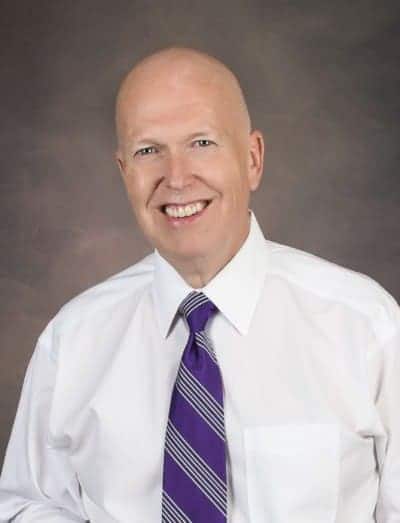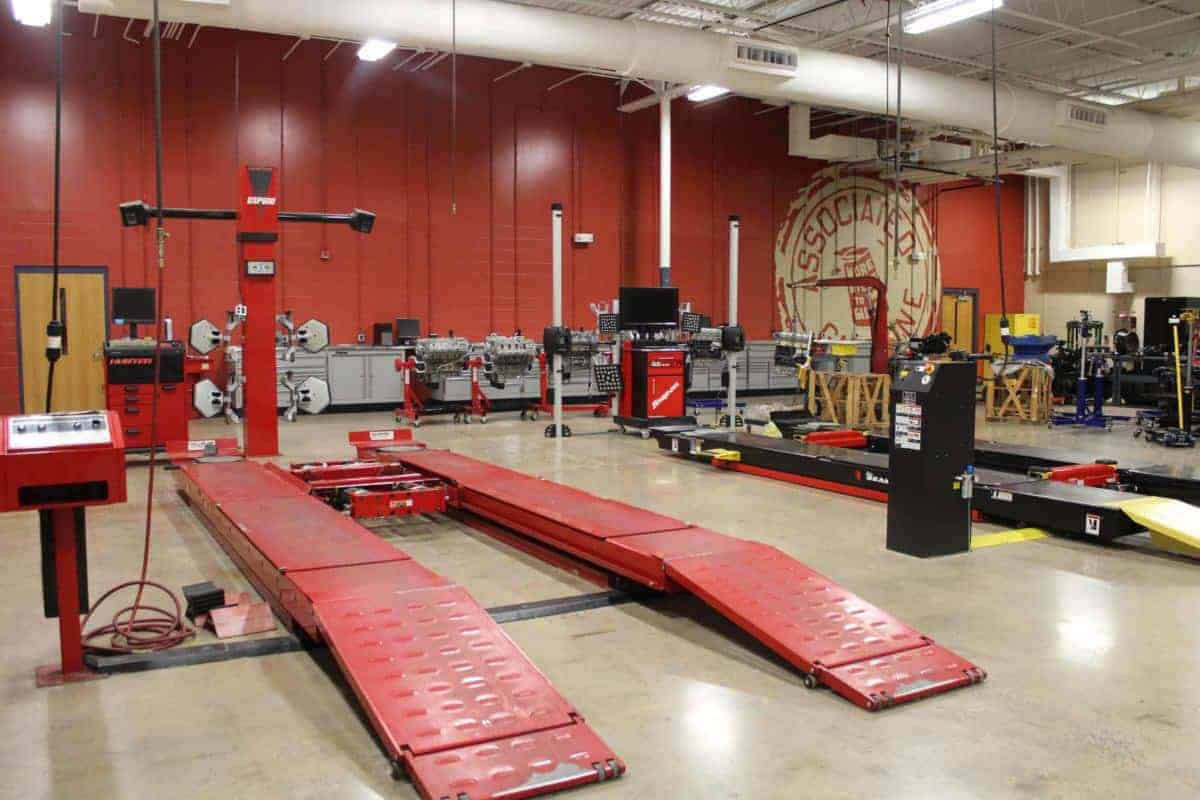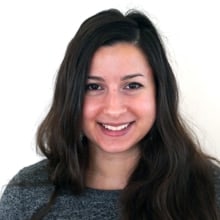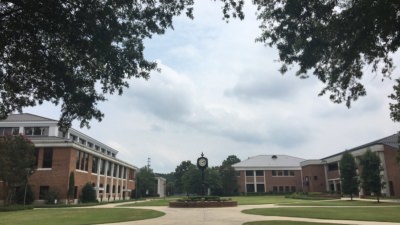As you may have heard by now, EducationNC — following an investment from the John M. Belk Endowment — has taken a deep dive into community college news. At the end of August, our team completed the “blitz” where we visited all 58 community colleges in the state in about one week and launched our community college-centered initiative, Awake58.
My fifth and final visit during Blitz Week was at Forsyth Technical Community College — a school that is a sweet spot for me because its home-base of Winston-Salem happens to be my hometown. I even took AP classes in high school on the college’s campus in a building formerly dubbed the “career center.” But during my most recent visit, I learned more about Forsyth Tech than I had ever known as a high school student. I visited programs from cybersecurity to nursing, broadcasting, digital effects and animation, and automotive systems.
During my visit, I also had the pleasure of sitting down for an interview with President Gary Green and Chief Academic Officer Joel Welch. The interview is particularly poignant as Welch is a finalist for president at Northeast State Community College in Tennessee and Green will be retiring at the end of this year after 17 years at Forsyth Tech. See some of our conversation below, edited for clarity and length.
Bendaas: Seventeen years is a long time! Why did you not leave?


Green: Well, I think that’s a good question. There have been opportunities, but one, the North Carolina community college system is recognized across the country as one of the best systems of community colleges … so that’s one of the things that drew me here, and one of the things that has kept me here is sort of the quality of the overall community college movement in North Carolina. At Forsyth Tech, we’ve been able to do some really positive things with the community. There’s really been good and important work to do to help the community, to help the economic growth of the community, to serve employers — particularly to serve people and to serve students here.
The quality of the work and the passion of the faculty and staff for what they’re doing has kept me here as well. I think you’ve probably seen some of the passion that people have for what they’re doing. They want to show you more. They want to tell you everything about it, but we have people that are just passionate about helping students to succeed, to complete their programs, to have successful outcomes in the workplace or when they transfer to senior institutions — and that makes it an exciting environment to work in.
Bendaas: I was trying to sum up this one week … and passion is definitely one word. It’s something I’ve found with instructors and with every president. I think that [dedication is] something I find with teachers in general, but at the community college level, it’s at a whole new level.
Green: I think it is. I came into community college education in 1976, and I was going to do it for two or three years. I’ve been in community colleges ever since. There is a passion for it.
You have an opportunity to serve people who may have come to the community college as their only opportunity to get the education and get the skills to improve their lives and the lives of their family. That becomes … almost a calling, to help those people.
You see it across the state. We’re serving about 700,000 people in North Carolina. That’s a large percentage of the people of North Carolina that are served by community colleges. It’s kind of an awesome responsibility that we are the places in communities large and small that people are turning to to get help. We certainly saw it during the recession when people were being laid off from work, or people were worried about getting laid off or their jobs being eliminated. And in huge numbers, they turned to the community colleges. That was the only place they had — in a sense — to turn for a future, and we stepped up. So it is a passion to help those people.
Bendaas: I would be interested in knowing what trends you’ve seen in enrollment over the past five years.
Green: I’d like to go back a little further than that. We had sort of a constant, steady growth through the early 2000s from around 2001 to 2008. We were growing two to four percent a year. Really beginning around 2007-2008, we absolutely took off. Between 2007 and 2012, during the peak of the recession, we grew 43 percent. That’s unheard of growth in an institution like this.
Since 2012, then we have dropped back, but we have not lost all of that enrollment. We’ve dropped about 20 to 25 percent during that time, but that has to be understood in the context of 43 percent growth the five years before that. What you’ve seen then is peaking, for us around 2012, and then it’s reduced some as the economy has gotten better — as there have been more jobs for people in our community, as the educational environment’s become more competitive with the universities. The environment that we operate in has changed, but we’re still doing the same core work. So while we’ve dropped, I don’t see that as an issue. We’ve now sort of flattened out over the last couple of years; we’ve been pretty steady in enrollment, and we see that continuing maybe with slight growth over the next few years now.
Bendaas: I’d like to move to the faculty side. Could you describe what your faculty recruitment and retention strategies look like, and how would you rate the success of your strategies to date? You probably have a lot of competitors in the region, too, so if you wanted to [discuss] that.
Green: Faculty recruitment and retention is absolutely key to the quality of what we’re doing and for the engagement of students that we have. So we have to spend a lot of time and effort thinking about how we’re going to recruit and keep faculty, particularly since we are dramatically underfunded for faculty.
If you look at the North Carolina community college system and you look at the SREB (Southern Regional Educational Board) data for salaries in education in general, you’ll find that North Carolina community college faculty salaries are further behind their peers in other states — more than the university systems are compared to other states or the K-12 [system]. You hear a lot about K-12, and I’m not saying that those other sectors of education don’t need support for funding faculty and teachers, but we’re in worse shape than any sector of higher education against our peers in the Southeast. I tell our legislators, ‘just get us to the level of Mississippi.’ Nothing against Mississippi, but the fact is, other southern states that haven’t traditionally shown the commitment to education that North Carolina has are ahead of us in terms of salaries.
It begins with that. It’s hard to recruit, and it’s hard to retain because of salaries.
The other thing that’s a challenge with that is the changing demands that we have for faculty to be able to adapt to new technology. We certainly see it in healthcare. We see it in IT. IT permeates everything now. We see it in advanced manufacturing. It’s extremely hard to hire today a really qualified person in welding or machining who is up to date on the newest technology because there’s such a demand in the economy for those people. So we have huge demands for technical knowledge.
Welch: The salary I think is one of the big things. I will say I don’t think it’s the only thing. I don’t think the money is the absolute driving force for a lot of our folks. Dr. Green mentioned earlier, for most of our faculty it’s about passion [and] who we reach. But we are getting a massive amount of pressure, not just from where we are compared to other higher education, but what’s happening in the marketplace. You look at your technical faculty specifically: salaries in the marketplace are climbing, and we need technicians, technologists, engineers, scientists to come in and teach our technical courses — so we’re battling with that.
The way that we reach out, one, we are looking for folks who want to give back, and we find a lot of those folks out there. Then, two, you’re not going to come in here and just sit around either. It’s got to be people who are invested in student success. We’re recruiting to that: what happens in the classroom, what happens outside of the classroom … We know we can’t do (unless the state funds us differently), we can’t do a lot about salaries.
But we can do a lot about the work environment — and Forsyth Tech specifically — we do a lot to make this a great place to work.
We have a strong family atmosphere. We try to be as flexible with people, our faculty, as we can be. We try to look for opportunities for people to grow. To give them opportunities to learn. Even as the budget was tight over the last couple of years, we’ve cut very little out of our professional development. We continue to provide and to deal with that.
We have a faculty member last year who had a death in the family. We have multiple faculty stepping up to cover that faculty member’s courses so that this person has time to deal with their family. It’s that type of atmosphere, it’s that working together, and we as an administration providing support within state rules … We want to be as flexible as we can. We want to take care of our people.
From a faculty standpoint specifically, we look at how we compare to other colleges within the state. We’ve invested in how we give raises to faculty to work to bring our faculty salaries up compared to our peer institutions in the state. We’re looking at that and how we invest our budget to do everything that we can. I think those come together to help us retain folks. We have a strong benefit package in how we work with our folks, and we’ve got some really good institutions around us. We have a lot of faculty and staff from those institutions wanting to come work here. I think that speaks to the atmosphere that we do drive.
I’ve been here about three years, and you’re not here long before you realize the family atmosphere, the care for each other, and I think that’s something that really helps us retain people.
Green: Goes back to that passion for what people are doing.
Bendaas: What potential for innovation and opportunities do you see for both your institution and the overall community college system?
Green: I think there is tremendous potential in programming and how we are aligning the programs around the needs of our community and the needs of our students for career opportunities, and those two things are together. We look at economic development in our community, and the career development for our students is sort of two sides of the same coin.
If we’re providing programming that’s aligned with community needs for our students, then they’re getting good career development. And if we’re getting career development that’s aligned with the skills that employers need, then we’re taking care of the workforce development needs of our community.
But one of the things that we see around innovation that has been really important to us over the last several years is looking at where the economy is going, what is driving the economy today broadly, as well as in our individual community. We see that in our area with the growth of such things as the growth of clinical health jobs. Our hospitals now here are the largest employers in our community.
The growth of IT and computer technology and how it’s changing how every job is done today. The growth of such things as biotechnology and nanotechnology and new materials … What gets really interesting is how those things intersect. So when you think about innovation in the workplace and innovation in the economy, it comes at the intersection of things like healthcare and IT with our new health information technology program. It comes in the intersection of clinical health and biotechnology with things like our clinical research program supporting medical research in our community — which is very important in our community given the presence of Wake Forest University Medical School and the major academic medical center here.
The intersection of IT and manufacturing with digital manufacturing. Robotics. Artificial intelligence. The whole CNC machining. 3D printing. All of that intersecting what was the traditional manufacturing, which was one of the reasons this college was started, with now IT. Innovation is happening along all those intersections, so we’ve got to prepare our students for that kind of environment and the new jobs and the new career opportunities that are being created.
We don’t talk a whole lot about jobs per se anymore. We talk about careers. There are a lot of jobs out there, but we are interested in getting our students on track for what is a career with a good, sustaining wage that will support themselves and help support a family.
And that’s happening around technology, around science, around mathematics, and the other core fields. It’s preparing students for an environment where they’re problem-solvers and can apply the technology that we’re learning.
You heard that in cybersecurity. James Brown answered that what students need to be able to do is show initiative and to be problem solvers, and you see that across the college. If they do that, then they’ll fit into an innovative economy.
Bendaas: I want to know … what keeps you up at night?
Green: One of the challenges is resources and funding, but that’s always a problem, so just set that aside. Okay?
What keeps me awake at night is how well are our students doing? How well are they completing? What happens to them after they leave us? What happens when they go into the job market? Are they being successful because of the skills and education and the problem-solving that they learned here?
Those are the kinds of things I worry about, and to be honest, not enough of our students are completing. We need to get more students through the pipeline, but we need to also be making sure that we’re looking at supporting them after that to make sure they’re successful. And I think they’re having real success when they complete. It’s getting them through to completion. So that means that all of our students that are men are completing as well as our women. That our African-American students are completing as well as white students, completing as well as Hispanic students and others. That we’re raising the bar for everybody, everybody’s doing better, and all of our students are coming along.
So that we have student success regardless of all the ways our students come to us who are different — difference in ages, difference in genders, difference in race and ethnicity, religion, sexual orientation, and identity. All the ways that people are different. That all those students are being successful.
And we know that today, there are some gaps there. So we have to work on that. I worry about that.
Those are the primary things, because if those things get taken care of, then the workforce issues in our community get taken care of. Our community can grow and our employers will grow the economy because one of the things we hear from our economic development agency — Winston-Salem Business, Inc. and others — is that today the first thing employers are looking for is a workforce. It’s a higher priority, even more than land and utilities and all of that kind of stuff, because they can find those, but they’ve gotta have the workforce.
If we can do that, if we can grow the pipeline, if we can have more students being successful and completing, if we can bring everybody up — then we’ll be successful.
Welch: I tell the faculty the thing that probably keeps me awake at night the most right now is that I talked to my partners in the secondary school system and you look at the pressure that was provided for graduation rate, and everything drove graduation rate. When I look at what we do with some of our performance-based funding and the pure pressure on completion … you heard Dr. Green start with ‘how do they do after they leave us?’
It’s not just about earning an associate’s degree. How do they do at the transfer institution? How do they advance at the company when we graduate them?
But a lot of time, the measures that are designed at a state and federal level — if they force us into a pure measure of completion, without rigor, we’re going to lose the value of our degree.
We can never give up the rigor of our programs and meeting the competencies and hitting the standards that we’ve got to hit. Everything as far as completion we’ve got to do. We’re not doing everything we need to do there by any means. But if that becomes the sole defining piece, and we don’t consider how they do when they transfer, how they do at their jobs … If we’re not digging into how men are doing, women are doing — all these things on that path, if it all becomes just that one issue, we’re going to lose sight of who we are.
It’s important that they earn the associate degree and complete. But if I turn out a thousand associate degrees next year and they all fail when they transfer, what’s the use of that? We want a good, comprehensive view that looks at job placement and career advancement, success at a transfer institution, and completion — absolutely critical.
Green: I want to say one other thing. I think it’s important. We talk about the numbers and the success of groups and all that. But it’s about individual people. I’ve sat here thinking about students I’ve known and one in particular comes to mind, and that’s a student named Kathy Proctor.
Kathy Proctor was in her 50s. Got laid off from work in the furniture industry. She worked in a furniture plant. Had finished high school, but that was it, and had worked there for 30 years, and was lost. She didn’t have income. She had two kids to support herself. She got to Forsyth Tech, and coming out of the furniture industry, she found biotechnology.
Here she was, an insecure 50-year-old having to go back to school when she had never been to higher education, never been to a college. Scared. She comes to us and she connects with this biotechnology program that’s creating some of the new jobs in our community.
She had an opportunity when President Obama was here. He was touring our biotech program and toured a class, and she got to meet the president. That’s pretty cool stuff. She got to meet President Obama, and in this lab-class setting, the president sort of took a step back and started talking to them — ‘What’s your story? What are you doing?’ Some of them had come out of high school, and she came out of the furniture industry. She talked about how important the Pell grants and the Trade Adjustment [Assistance] funds had been for her to help her go back to school. That she had two daughters that were teenagers, and she had to support them, and so on.
White House staff picked up on that. Loved her story. Two weeks later, the president invites her to Washington to be there for the State of the Union, and he talked about her in the State of the Union. He recognized her sitting in the galleries, and her teenagers got to watch the State of the Union from the White House while she was over there at the Capitol.
She graduated and went to work for Herbalife out in Union Cross as Quality Control Technician. From there, because she had a good salary, she was able to help her daughters go to school. So they end up going to NC State and getting degrees in engineering.
I saw her again a couple years ago. She just started cataloging all the ways that connecting with Forsyth Tech had literally changed her life and had changed the life of her family and her daughters. She told me she would have never been able to support her daughters going to college, and now they’re getting degrees in engineering. They’ve got good careers in front of them.
We look at groups and students and enrollment and numbers and budgets and funds … but it’s about individual people and the lives we’re changing.
Stay tuned for more from my visit at Forsyth Tech, and keep up with all of our community college coverage @Awake58!



